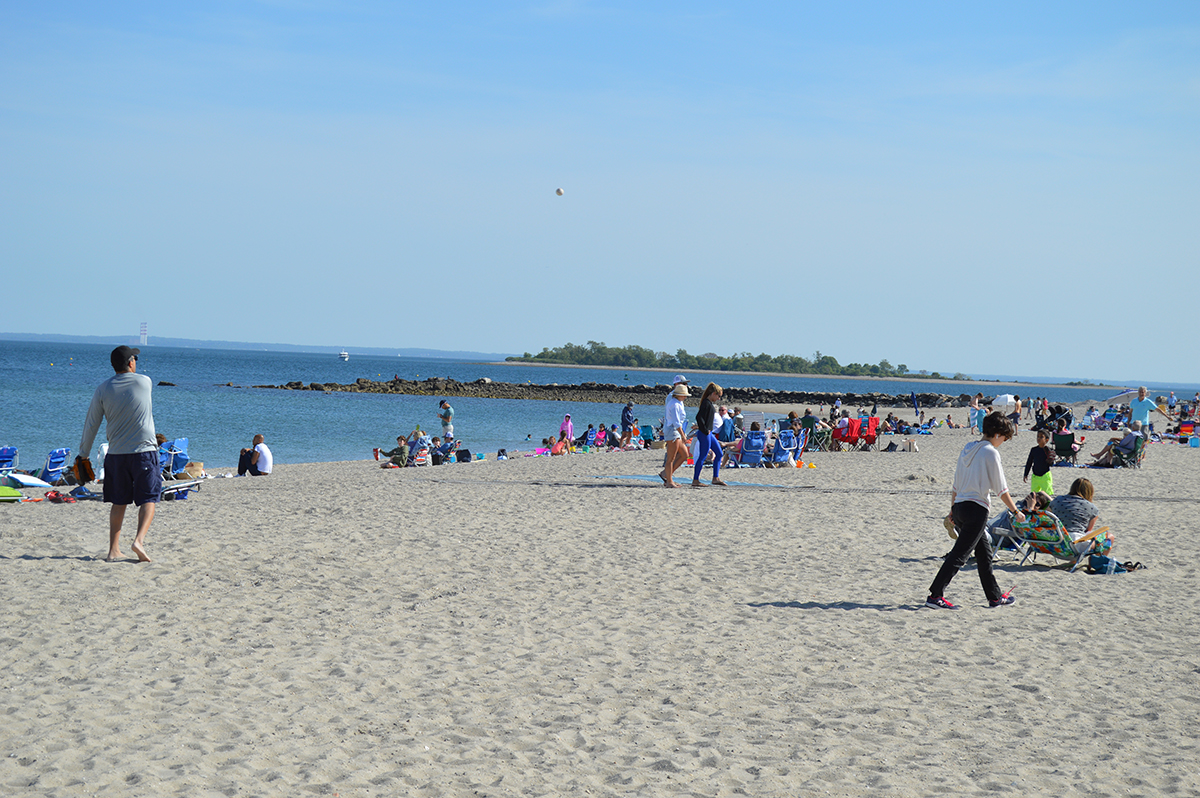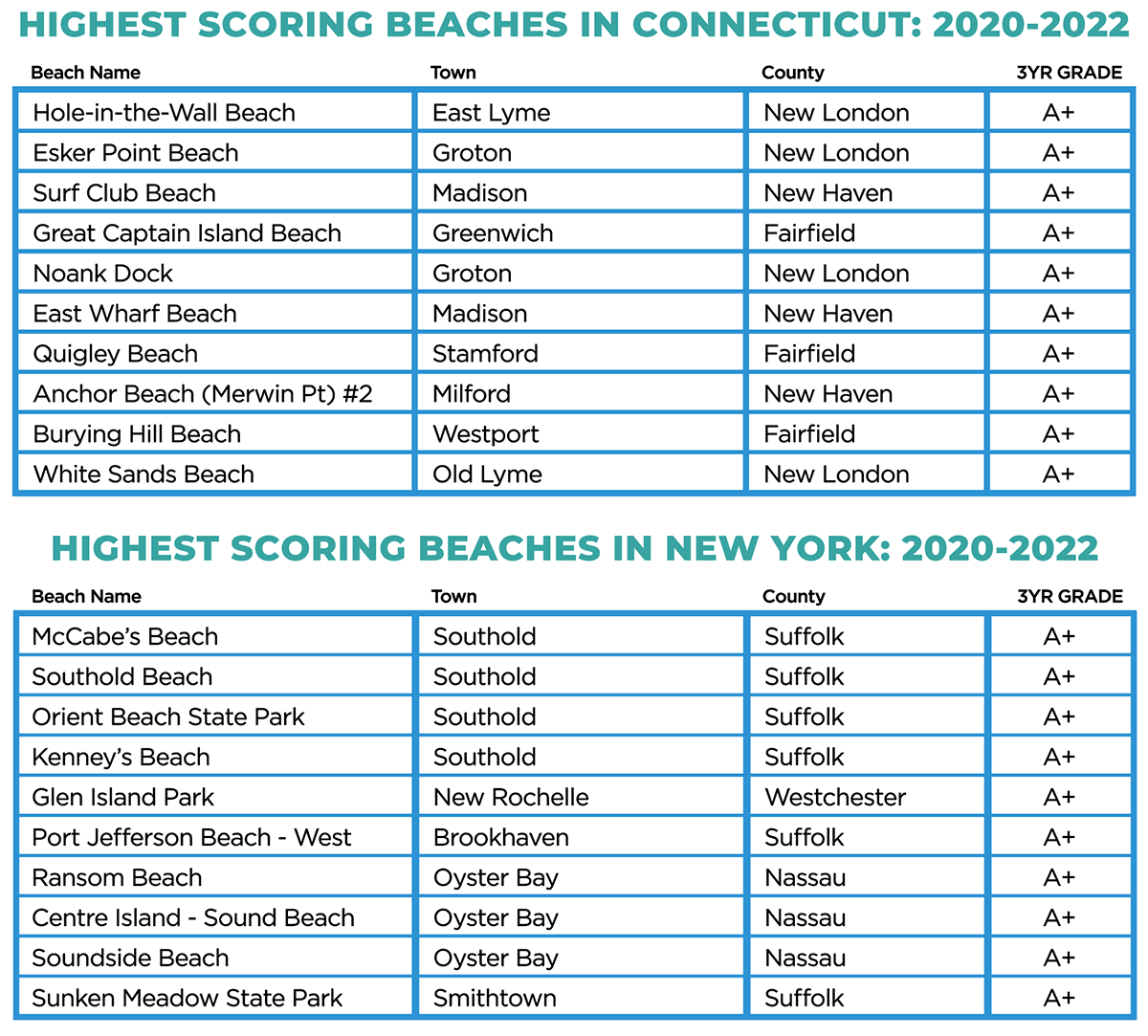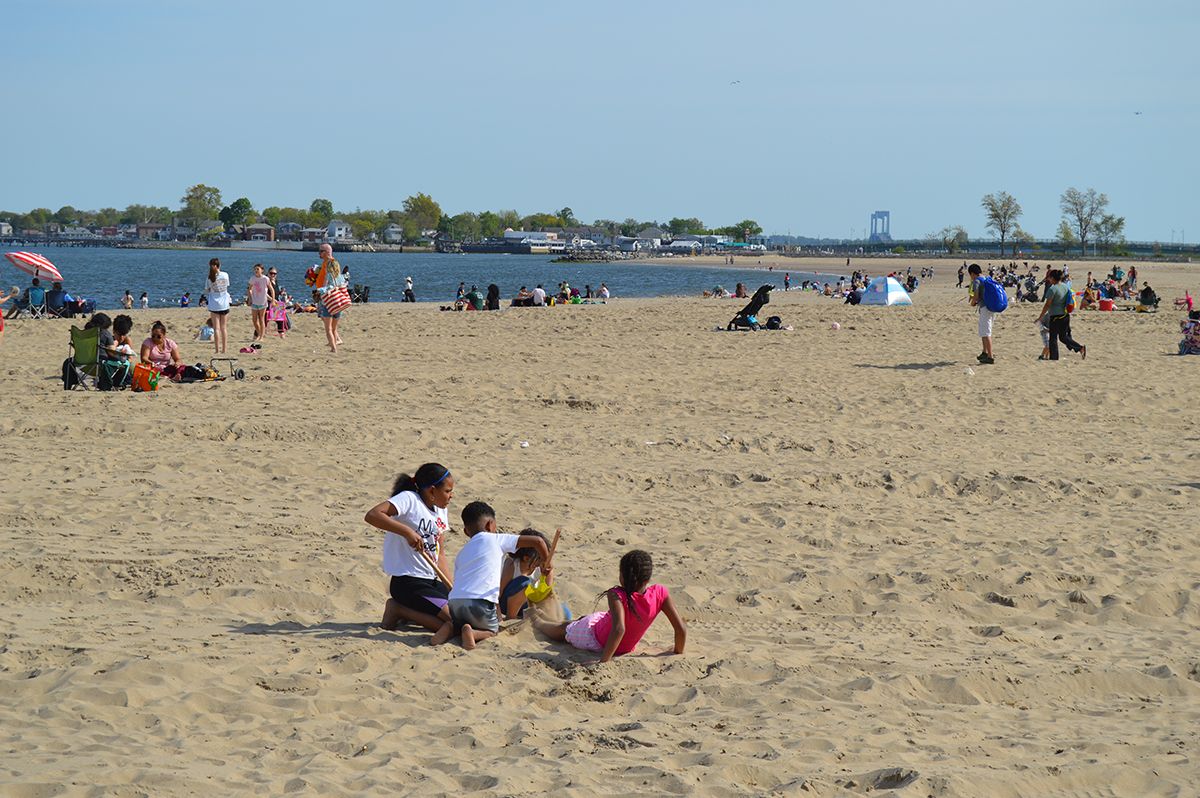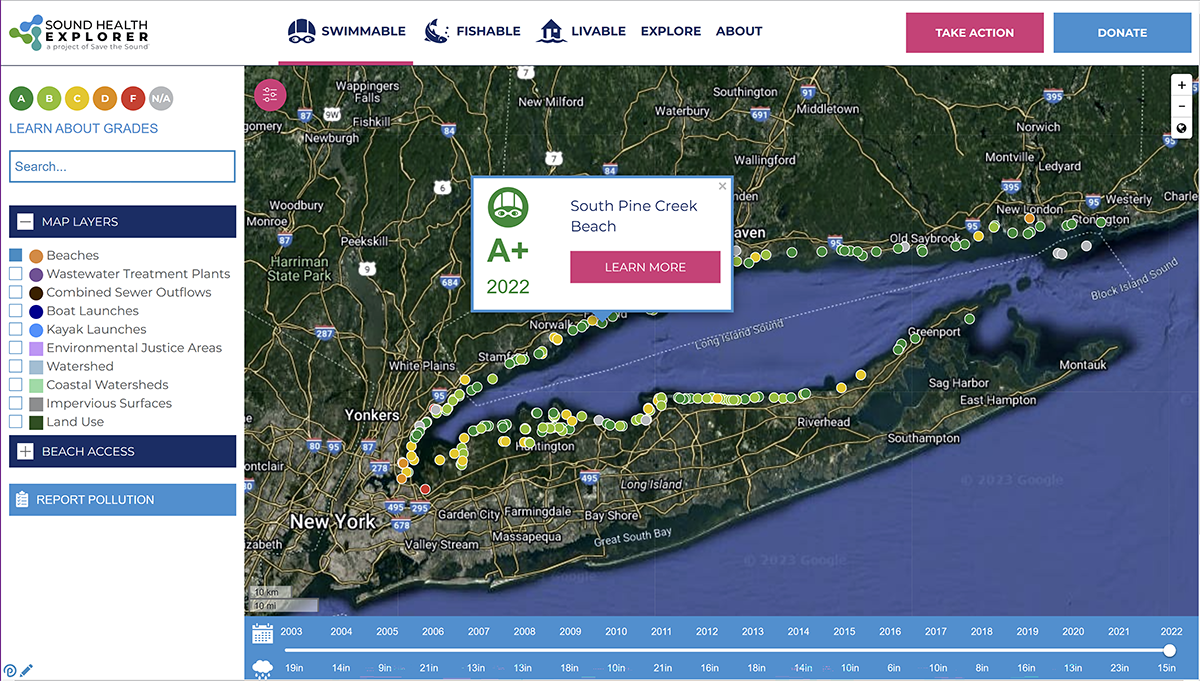Find out how your Long Island Sound beaches fared
Get your copy of the 2023 Beach Report
Download previous Beach Report Cards: 2021 • 2019 (updated Nov 2020)

Save the Sound released results of our 2023 Long Island Sound Beach Report on June 21 – the first day of summer – during simultaneous press conference at North Hempstead Beach Park in New York and Lighthouse Point Park in Connecticut. The Beach Report offered good news for swimmers, noting that 78% of the more than 200 Sound beaches highlighted earned “A” or “B” grades for water quality in the 2022 swimming season. The biennial report included a list of the 10 highest scoring public beaches in New York and Connecticut based on a three-year average of water quality grades (10 each in NY and CT), and presented comprehensive grades for 207 swimming beaches 2020, 2021, and 2022

For the first time, the Beach Report also provided a list of the 10 lowest scoring public beaches around Long Island Sound. Identifying beaches in need of increased pollution reduction is one of the reasons we publish this Report. We hope the Beach Grades will be used to open dialogue between residents, interested organizations, and local officials about potential solutions to compromised water quality.
David Ansel, vice president of water protection for Save the Sound: “Water quality at beaches across Long Island Sound has come so far – but we may be at a tipping point. Increasing rainfall brought on by climate change threatens to undo decades of progress unless we act now. We’re calling on elected officials to prioritize investment in repairs and improvements to sewer lines and stormwater systems. Steps we take in the next five years may well set the course for the health of Long Island Sound over the next 50.”
Rain events have increased in frequency and intensity, triggering an increasing number of beach sample failures. The overall failure rate of beach samples was nearly three times higher in wet weather than in dry weather (13.5% to 5.2%). This represents an even greater disparity than the data revealed in the 2021 Beach Report.
Beach closures and failures after storms (often the day after rainfall ends, though closures could last several days) are concerning for several reasons. First, elevated levels of fecal contamination after rain can indicate untreated sewage has made its way into a system of pipes only designed for stormwater. Second, beaches with abundant wet weather failures tend to have large swaths of impervious surfaces (e.g. roads, roofs, parking lots) that lead to high volumes of stormwater flowing to beaches.
From 2020 to 2022, the region experienced the most rain during a three-year period that has been recorded in a decade. The areas surrounding Long Island Sound received an average of 17 inches of rain during the swimming season – a number exacerbated by the 23 inches of rain that fell in 2021, the highest total since Save the Sound began tracking the data in 2009. The only three-year period that saw more rainfall was 2011-2013, when the area averaged 18.3 inches, a stretch that included Hurricane Irene one year and Superstorm Sandy the next. This trend threatens to reverse the improvements in water quality secured over recent years. If those improvements are to be maintained or enhanced, it’s clear that investments towards improving local stormwater and wastewater systems are crucial.

Key findings of Save the Sound’s 2023 Long Island Sound Beach Report include:
- 78% of Long Island Sound beaches earned an “A” or “B” grade.
- That leaves 22% of Sound beaches with moderate to poor grades, from C+ and below. Three beaches received an “F” grade in 2022.
- One interesting fact the data shows is that a beach scoring poorly for water quality can be located right around the corner from a beach with a good grade. Even beaches directly next to each other can receive very different grades. This is why we say that water quality at beaches is “hyperlocal.”
- Rain is a primary driver for water pollution at numerous area beaches. The overall failure rate of beach samples was nearly three times as high in wet weather than in dry weather – 13.5% to 5.2%. This is an even greater disparity than monitored in the 2021 Beach Report. Moreover, the frequency of wet weather fails increased 2.1% for the 2023 report.
- From 2020 to 2022, the region experienced the most rain during a three-year period that has been recorded in a decade. The areas surrounding Long Island Sound received an average of 17 inches of rain during the swimming season – a number exacerbated by the 23 inches of rain that fell in 2021, the highest total since Save the Sound began tracking the data. The only three-year period that saw more rainfall was 2011-2013, when the area averaged 18.3 inches, a stretch that included Hurricane Irene one year and Superstorm Sandy the next.
- Between 2020 and 2022, the Sound Shore of Westchester County and New York City averaged the highest rates of failure in both wet (14.9%) and dry (5.7%) conditions. The other regions in the western half of Long Island Sound, Connecticut West (10.9%) and Nassau County (10.4%), also saw a greater frequency of wet weather failures.
- Beaches in New York City have struggled over the years with water quality grades for reasons you might expect: major population density and the impact of combined sewer and stormwater systems. New York City has made important investments in sewage treatment and infrastructure repairs – but additional investment is still required.
- Of the 12 NYC beaches monitored, 11 scored grades of C or below. Orchard Beach in the Bronx has often been an exception, grading well, for instance, in 2020 and 2021 at A- and A, respectively. But Orchard Beach earned a C in 2022.
- Orchard Beach stands out for another reason, which points to a broader problem along the shoreline of the Sound. Orchard Beach is the only public beach in the Bronx open to the general public.
- Access to beaches can be challenging across New York and Connecticut. Nearly one-third of the monitored beaches are designated as private. Many beaches have restrictions on use by non-residents, such as onerous fees. For example, at a beach in Connecticut, non-residents are allowed access during the swimming season but must pay a daily parking fee of $70 on weekends and holidays between May 1 and September 30. We urge local communities to find a balance when setting fees or policies for beach access, so that everyone can enjoy the beautiful beaches that border Long Island Sound.
Save the Sound created a dedicated website—www.SoundHealthExplorer.org—which features interactive maps listing beach water quality and from which the full Beach Report can be downloaded. The site has been enhanced to include information on which beaches offer public access, the location of kayak and canoe entry ramps, and more useful information. The site highlights more than a decade of water quality data for Long Island Sound.

Residents, as well as local and regional officials, are urged to check www.soundhealthexplorer.org for data regarding specific beaches. Often, issues forcing beaches into frequent closures can be addressed when local water quality patterns are carefully assessed and associated pollution sources identified.
